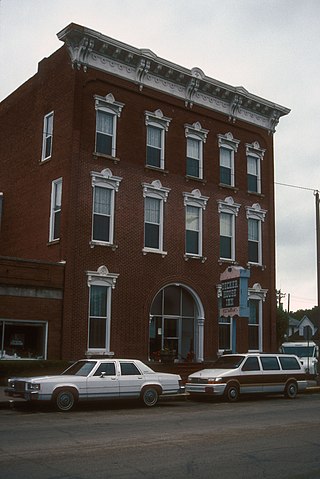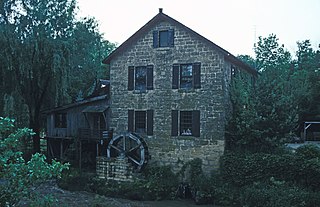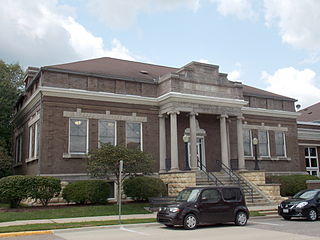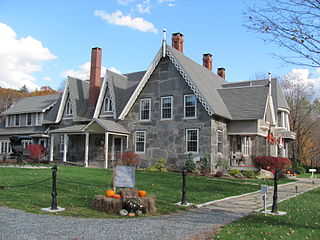
Jackson County is a county located in the U.S. state of Iowa. As of the 2020 census, the population was 19,485. The county seat is Maquoketa.

Maquoketa Caves State Park is a state park of Iowa, United States, located in Jackson County. It stands northwest of the city of Maquoketa. In 1991 111 acres (45 ha) on the east side of the park were listed as a historic district on the National Register of Historic Places.

The Jackson County Courthouse, also known as Old Jackson County Courthouse or Bellevue Elementary School, is a historic building and former courthouse for Jackson County, Iowa, United States. It is located in Bellevue and was built in the vernacular Greek Revival style in 1845. It currently serves as a portion of Bellevue Elementary School, the oldest functioning school in the state of Iowa.

The Gibson-Todd House was the site of the hanging of John Brown, the abolitionist who led a raid on Harpers Ferry, West Virginia before the opening of the American Civil War. The property is located in Charles Town, West Virginia, and includes a large Victorian style house built in 1891.

There are eight properties listed on the National Register of Historic Places (NRHP) in Linn County, Kansas. Two of the sites are the location of historic events. The Marais des Cygnes Massacre Site is the location of the Marais des Cygnes massacre, an 1858 event during Bleeding Kansas in which pro-slavery advocates kidnapped 11 anti-slavery settlers, killing five of them. John Brown temporarily used the site as a fort, and the property was listed on the NRHP in 1971. The Battle of Mine Creek Site preserves the location of the Battle of Mine Creek, which was fought in 1864 as part of Price's Raid during the American Civil War. Confederate general Sterling Price's army was retreating after being defeated at the Battle of Westport and was attacked by pursuing Union troops. Price's Confederate lost heavily in men and supplies. The site was added to the NRHP in 1973.

The Linn County Courthouse is located on May's Island in the middle of the Cedar River in Cedar Rapids, Iowa, United States. It, along with the Veterans Memorial Building and two other buildings, is a contributing property to the May's Island Historic District that was listed on the National Register of Historic Places in 1978. The courthouse is the third building the county has used for court functions and county administration.

The Stone Jail Building and Row House are two adjacent stone buildings located on Water Street in Tonopah, Nevada. The jail was built in 1903 and the adjacent row house in 1908. Both building were at one time used as a brothel. The buildings were added to the National Register of Historic Places in 1982.

The Decker House Hotel is a historic building located in Maquoketa, Iowa, United States. James Decker, an entrepreneur from Watertown, New York held numerous real estate holdings in and around Maquoketa. He built the first Decker House, a frame structure, in 1856. After Maquoketa was named the county seat in 1873, Decker decided to replace it. The three-story, brick, Italianate building was designed by Watertown architect W.W. Tucker. Its decoration is limited to the north and east elevations. Noteworthy, is its metal cornice and window hoods. It opened in May 1878, and it had two other competitors in town at that time. Following his death in 1881, James Decker's son Leonard took over his holdings in New York and Iowa. He moved into the Decker House in 1885 and died there in 1900. The building has subsequently lost its entrance porch, original front doors and the pediment over the cornice. It was listed on the National Register of Historic Places in 1978.

The Cundill Block is a historic building located in Maquoketa, Iowa, United States. Local photographer Will Cundill had this two-story brick commercial building constructed in 1882. His studio was originally located on the second floor before he moved it to the main floor in 1895 when he built an addition onto the back. A variety of retail businesses have occupied the commercial space over the years. The building is representative of the brick commercial buildings that were built in Maquoketa in the 1880s and the 1890s. It features simple brick hoodmolds over the windows and a brick patterned cornice across the top. Although covered, the iron storefront remains in place. The building was listed on the National Register of Historic Places in 1991.

The Maquoketa Company–Clinton Machine Company Administration Building, also known as Building #7: Clinton Engines Corporation Administration Building, is a historic building located in Maquoketa, Iowa, United States. It was listed on the National Register of Historic Places in 2006.

Seneca Williams Mill is a historic building located just outside of Maquoketa, Iowa, United States. Originally known as Oakland Mill, it was built by Joseph Willey in 1867. The 2½-story stone building has a partial basement and is capped with a gable roof. A water-powered turbine, still extant, supplied the power to operate the mill. The location of the mill race can still be seen on the east side of the property, and permanents of the damn remain in Prairie Creek. None of the mill workings remain on the inside. Willey sold the mill to Seneca Williams in 1867, and he operated in until 1904. The building was converted into a barn in 1920. The building was listed on the National Register of Historic Places in 1976. Wildlife artist Patrick J. Costello used the old mill as a residence and studio from 1979 to 2006. His daughter Tracy Costello Taylor has operated it since as a reception hall.

The Maquoketa Public Library is located in Maquoketa, Iowa, United States. The Maquoketa Literary Society was organized as early as 1851, and the Boardman Library Institute was founded in 1885. The community applied to the Carnegie Corporation of New York for a grant to build a free public library, and on March 14, 1902, they were awarded $12,500. The total cost of acquiring the property and constructing the building was $15,000, which they raised by public contributions and entertainments. Independence, Iowa architect Harry Netcott designed the Neoclassical building. It is a single-story brick structure that rests on a raised limestone basement. Bedford stone was used for the trim. It features a symmetrical facade, with columns in the Ionic order that frame the portico. The interior features a columned rotunda. It was dedicated on January 19, 1904. The Boardman Library Institute merged with the Free Public Library after the new building was completed. The roofline was altered slightly when a new roof was added around the middle of the 20th century.

Hurstville Historic District is a nationally recognized historic district located north of Maquoketa, Iowa, United States. It was listed on the National Register of Historic Places in 1979. At the time of its nomination it included three areas: the former lime manufacturing works, a farmstead, and the townsite. All that remains are the four kilns, and an old warehouse. Both the townsite, which was across the road and to the southwest, and the farmstead, which was behind the kilns to the south, are gone. Also gone are the remaining company buildings, with the exception of the old warehouse, which were across the road to the west. The houses in the townsite were side-gable cottages. Many lacked indoor plumbing into the 1970s and were vacant. The farmstead included 20 structures devoted to domestic or agricultural use. Two large barns were the most notable structures. The farm served the needs of the town. The most significant structures in the district were the lime kilns.

The Milton Godard House is a historic building located southwest of Maquoketa, Iowa, United States. This house is considered an excellent example of limestone craftsmanship and design. It is one of over 217 limestone structures in Jackson County from the mid-19th century, of which 101 are houses. Very few are in this part of the county, and most are vernacular construction. The Godard house has elements on the Gothic Revival style, especially in the fenestrations. It is also unusual in that it is two different houses built at two different times. Local tradition says that five stonemasons from Germany were brought here to work on the house, and they stayed here for eight years until it was completed. Godard was a Connecticut native who settled here in 1845. His closest neighbors to the south and west at that time were 15 miles (24 km) away. He donated land to the east of his house in the 1880s for a Methodist church. The church was razed in 1926, but the cemetery remains. The house was listed on the National Register of Historic Places in 1992.
The Anson Wilson House is a historic residence located south of Maquoketa, Iowa, United States. Wilson was a native of Canada who arrived in Jackson County in 1839 and squatted on his claim on the prairie from 1840 until the US Government made it available for purchase in 1846. In his early years he worked a variety of manual jobs before settling into farming. With stonecutter F. Zimmerman built this two-story limestone house in 1860. Outbuildings for the farming operation were built about the same time. The rectangular plan house is composed of coarsely-dressed limestone blocks laid in a random ashlar pattern. A single-story frame addition was built on the back of the house in 1896. It was replaced by a more modern version in 1969. The house was listed on the National Register of Historic Places in 1977.

The Bassnett–Nickerson House is a historic house located at 116 South Vermont in Maquoketa, Iowa.

The West Pleasant Street Historic District is a nationally recognized historic district located in Maquoketa, Iowa, United States. It was listed on the National Register of Historic Places in 1991. At the time of its nomination, it contained 50 resources, which included 29 contributing buildings, 21 non-contributing buildings, and one non-contributing site. The historic district is primarily a residential area that was built during Maquoketa's "Boom Years" (1873-1899) and the "Comfortable Years" (1900-1922). The first house in the district was built in 1863 and the last in 1914. This is where many of the city's business and professional leaders choose to build their houses. Most of the 28 houses were likely not designed by an architect, but, were crafted in the "High Style" of the time by local builders. With the exception of Greek Revival, all the major styles of the period built in Maquoketa are found here. Eight of the houses and one of the three remaining carriage houses are brick structures; the rest are wood.

The Insane Asylum at the County Poor Farm is a historic building located north of Andrew, Iowa, United States. It is one of over 217 limestone structures in Jackson County from the mid-19th century.

The Chicago, Milwaukee & St. Paul Narrow Gauge Depot-LaMotte is a historic building formerly located in La Motte, Iowa, United States. The Chicago, Bellevue, Cascade & Western Railroad was incorporated in August 1877, to build a narrow-gauge railway from Bellevue to Cascade. Narrow-gauge was chosen because it was cheaper to build, and it could negotiate the tight turns on the rugged terrain better. Construction began the following year, but lack of money doomed the project. The Chicago, Clinton, Dubuque and Minnesota Railroad took over the project, and it was completed on December 30, 1879. The first train reached Cascade on January 1, 1880. Ten months later they sold all their holdings to the Chicago, Milwaukee & St. Paul Railroad, and this line became a branch line of the Milwaukee Road. That same year a frame depot was built in La Motte. It served as a combination freight and passenger station until it was destroyed by fire in 1910. This depot replaced it the following year. The 1½-story frame combination station represents the corporate style and standardized practices of the Milwaukee Road. However, it reflects the depots they built in the late 19th century, so it was somewhat outdated when it was built.

Glimmerstone is a historic mansion house on Vermont Route 131, west of the village center of Cavendish, Vermont. Built 1844–47, it is a distinctive example of Gothic Revival architecture, built using a regional construction style called "snecked ashlar" out of locally quarried stone flecked with mica. The house was listed on the National Register of Historic Places in 1978.






















